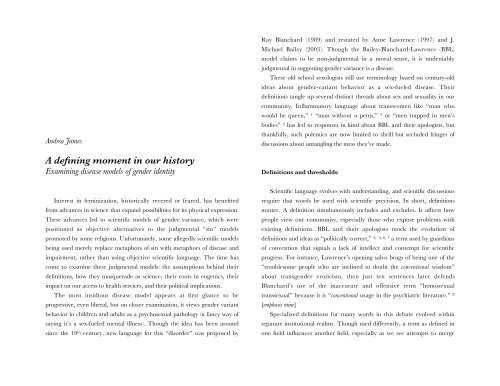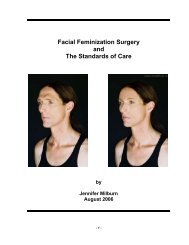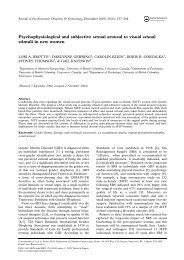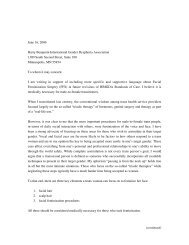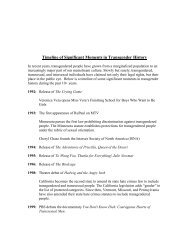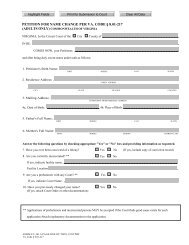A defining moment in our history - Transsexual Road Map
A defining moment in our history - Transsexual Road Map
A defining moment in our history - Transsexual Road Map
Create successful ePaper yourself
Turn your PDF publications into a flip-book with our unique Google optimized e-Paper software.
Andrea JamesA <strong>def<strong>in</strong><strong>in</strong>g</strong> <strong>moment</strong> <strong>in</strong> <strong>our</strong> <strong>history</strong>Exam<strong>in</strong><strong>in</strong>g disease models of gender identityRay Blanchard (1989) and restated by Anne Lawrence (1997) and J.Michael Bailey (2003). Though the Bailey-Blanchard-Lawrence (BBL)model claims to be non-judgmental <strong>in</strong> a moral sense, it is undeniablyjudgmental <strong>in</strong> suggest<strong>in</strong>g gender variance is a disease.These old school sexologists still use term<strong>in</strong>ology based on century-oldideas about gender-variant behavior as a sex-fueled disease. Theirdef<strong>in</strong>itions tangle up several dist<strong>in</strong>ct threads about sex and sexuality <strong>in</strong> <strong>our</strong>community. Inflammatory language about transwomen like “man whowould be queen,” 1 “man without a penis,” 2 or “men trapped <strong>in</strong> men’sbodies” 3 has led to responses <strong>in</strong> k<strong>in</strong>d about BBL and their apologists, butthankfully, such polemics are now limited to shrill but secluded fr<strong>in</strong>ges ofdiscussions about untangl<strong>in</strong>g the mess they’ve made.Def<strong>in</strong>itions and thresholdsInterest <strong>in</strong> fem<strong>in</strong>ization, historically revered or feared, has benefitedfrom advances <strong>in</strong> science that expand possibilities for its physical expression.These advances led to scientific models of gender variance, which werepositioned as objective alternatives to the judgmental “s<strong>in</strong>” modelspromoted by some religions. Unfortunately, some allegedly scientific modelsbe<strong>in</strong>g used merely replace metaphors of s<strong>in</strong> with metaphors of disease andimpairment, rather than us<strong>in</strong>g objective scientific language. The time hascome to exam<strong>in</strong>e these judgmental models: the assumptions beh<strong>in</strong>d theirdef<strong>in</strong>itions, how they masquerade as science, their roots <strong>in</strong> eugenics, theirimpact on <strong>our</strong> access to health services, and their political implications.The most <strong>in</strong>sidious disease model appears at first glance to beprogressive, even liberal, but on closer exam<strong>in</strong>ation, it views gender variantbehavior <strong>in</strong> children and adults as a psychosexual pathology (a fancy way ofsay<strong>in</strong>g it’s a sex-fueled mental illness). Though the idea has been arounds<strong>in</strong>ce the 19 th century, new language for this “disorder” was proposed byScientific language evolves with understand<strong>in</strong>g, and scientific discussionsrequire that words be used with scientific precision. In short, def<strong>in</strong>itionsmatter. A def<strong>in</strong>ition simultaneously <strong>in</strong>cludes and excludes. It affects howpeople view <strong>our</strong> community, especially those who expose problems withexist<strong>in</strong>g def<strong>in</strong>itions. BBL and their apologists mock the evolution ofdef<strong>in</strong>itions and ideas as “politically correct,” 4, 5, 6, 7 a term used by guardiansof convention that signals a lack of <strong>in</strong>tellect and contempt for scientificprogress. For <strong>in</strong>stance, Lawrence’s open<strong>in</strong>g salvo brags of be<strong>in</strong>g one of the“troublesome people who are <strong>in</strong>cl<strong>in</strong>ed to doubt the conventional wisdom”about transgender eroticism, then just ten sentences later defendsBlanchard’s use of the <strong>in</strong>accurate and offensive term “homosexualtranssexual” because it is “conventional usage <strong>in</strong> the psychiatric literature.” 8[emphasis m<strong>in</strong>e]Specialized def<strong>in</strong>itions for many words <strong>in</strong> this debate evolved with<strong>in</strong>separate <strong>in</strong>stitutional realms. Though used differently, a term as def<strong>in</strong>ed <strong>in</strong>one field <strong>in</strong>fluences another field, especially as we see attempts to merge
Andrea JamesA <strong>def<strong>in</strong><strong>in</strong>g</strong> <strong>moment</strong> <strong>in</strong> <strong>our</strong> <strong>history</strong>biology, psychology, law, and medic<strong>in</strong>e <strong>in</strong>to biopolitics. 9 With<strong>in</strong> the currentmedico-juridical system, cl<strong>in</strong>ical thresholds affect legal thresholds and viceversa.Imprecise and idiosyncratic def<strong>in</strong>itions plague this debate. The BBLmodel declares transsexual women are men with one of two sexual desires:“homosexual” (males aroused by males) and “autogynephilic” (malesaroused by the thought or image of themselves as women). Both categoriesefface <strong>our</strong> identities as women, but “autogynephilia” is more problematic <strong>in</strong>many ways. One major problem is the tendency for some who embrace theterm to look at the etymology and th<strong>in</strong>k it denotes an <strong>in</strong>nocent and happyform of fem<strong>in</strong>ist self-esteem: “I love myself as a woman!” they’ll say. I dotoo, but that’s not what this word denotes. When I say, “‘Autogynephilia’ isdef<strong>in</strong>ed by its creator as a type of paraphilia,” some say, “Well, that’s nothow I use it.” That’s like say<strong>in</strong>g someone is a pedophile because she loveschildren, or that someone is a zoophile because he loves his pets. Thoseterms are cl<strong>in</strong>ical and legal descriptors. Yes, “pedophile” literally means“love of children” <strong>in</strong> Greek, and “autogynephile” means “love of self aswoman,” but both terms are <strong>in</strong>exorably l<strong>in</strong>ked to their cl<strong>in</strong>ical orig<strong>in</strong>s aspsychosexual pathologies.Call<strong>in</strong>g oneself or others “autogynephilic” is participat<strong>in</strong>g <strong>in</strong> one’s ownpathologization, and it legitimizes this fake disease when people claim theydon’t have it. BBL are engag<strong>in</strong>g <strong>in</strong> scientific McCarthyism, where they claima hallmark of “autogynephilia” is that those afflicted will deny it. Anyrefutation becomes proof they are right, a no-w<strong>in</strong> situation like ask<strong>in</strong>g“when did you stop beat<strong>in</strong>g y<strong>our</strong> wife?”When we say “autogynephilia” is a made-up disease, some mistakenlyth<strong>in</strong>k we are claim<strong>in</strong>g erotic <strong>in</strong>terest <strong>in</strong> fem<strong>in</strong>ization is made-up, too.Obviously, this exists. Many women <strong>in</strong> <strong>our</strong> community have been very openand honest about their erotic <strong>in</strong>terest, 10 yet still take issue with label<strong>in</strong>g it adisease. 11Sex and sexualityMy response to “sexology” is similar to how a person of color mightrespond to “raceology.” I question anyone who seeks to draw bright l<strong>in</strong>esbetween nuanced possibilities of sex and sexuality, especially when theyclaim their attempt is science <strong>in</strong>stead of someth<strong>in</strong>g arbitrary and subjective.Try<strong>in</strong>g to map a scientific schema onto complex traits and behaviors is liketurn<strong>in</strong>g an impressionist pa<strong>in</strong>t<strong>in</strong>g <strong>in</strong>to a pa<strong>in</strong>t-by-numbers. Those who fearmiscegenation of the sexes or sexualities are just like those racists who use“science” to re<strong>in</strong>force socially constructed categories of ethnicity. As AnneFausto-Sterl<strong>in</strong>g notes, “Label<strong>in</strong>g someone a man or a woman is a socialdecision. We may use scientific knowledge to help us make the decision, butonly <strong>our</strong> beliefs about gender—not science—can def<strong>in</strong>e <strong>our</strong> sex.Furthermore, <strong>our</strong> beliefs about gender affect what k<strong>in</strong>ds of knowledgescientists produce about sex <strong>in</strong> the first place.” 12What k<strong>in</strong>ds of knowledge about sex are BBL produc<strong>in</strong>g? They claimvariously that homosexuality appears to be an evolutionary mistake 13 and a“developmental error,” 14 and gender variance is a “defect <strong>in</strong> a man’s sexuallearn<strong>in</strong>g,” 15 and a “sexual problem.” 16 It makes sense that a doctor wouldchoose a disease metaphor and psychologists would use a mental disordermodel to describe their observations and impressions. If we have a disorder,then what is the “order” to which they adhere? They imply the “purpose”and “function” of sex and sex organs is procreation. Why, it’s so obviouslytrue that the belief shouldn’t even be exam<strong>in</strong>ed, right? Accord<strong>in</strong>g to peoplewho believe this overly simplified idea, males have evolved (or weredesigned) to be attracted to females, and vice versa. In their worldviews,anyth<strong>in</strong>g that deviates from that is, well, deviant.Well, to borrow a phrase, a few troublesome people are <strong>in</strong>cl<strong>in</strong>ed todoubt this conventional wisdom. 17 Many of us question Lawrence’s claimthat sexual desire is “that which moves us most.” 18 We po<strong>in</strong>t to <strong>our</strong>experiences and feel <strong>our</strong> identities are what drive us; Wyndzen showspsychology supports <strong>our</strong> recognition of how powerful a force “identity” canpage 2
Andrea JamesA <strong>def<strong>in</strong><strong>in</strong>g</strong> <strong>moment</strong> <strong>in</strong> <strong>our</strong> <strong>history</strong>be. 19 We even question some passages of Darw<strong>in</strong> and the Bible (at the sametime, no less!). BBL get very upset when highly respected evolutionarybiologists like Roughgarden 20 or Gould 21 question their most deeply-heldbeliefs about sexual selection and human behavior.Eugenics, genetics, degenerates, genderThe words “eugenics,” “genetics,” “degenerates,” and “gender” allderive from the same Greek root mean<strong>in</strong>g “to produce or br<strong>in</strong>g forth life.”Some sciences and some religions seek to expla<strong>in</strong> <strong>our</strong> genesis and control<strong>our</strong> reproduction of subsequent generations. New reproductive technologiesare usher<strong>in</strong>g <strong>in</strong> a host of bioethical issues and rais<strong>in</strong>g the specter of a newwave of eugenics, where the genocide (another related word) will happenbefore or shortly after conception, after genetic material is screened for“undesirable” traits. Should people with Down Syndrome or dwarfism beelim<strong>in</strong>ated from the gene pool? How about <strong>in</strong>tersexed people? If Bailey’scolleagues f<strong>in</strong>d the “gay gene,” 22 should we wipe out sexual m<strong>in</strong>orities, too?What about gender m<strong>in</strong>orities? Will we see a “transgenocide”? Who decideswhat’s a disease or a degeneracy?As evidenced by BBL’s metaphors of disorder and disease, people canonly express ideas <strong>in</strong> the language they have available. Their models of sexand sexuality orig<strong>in</strong>ated with doctors and crim<strong>in</strong>ologists <strong>in</strong> the late 19 thcentury eugenics movement, and BBL’s ideas haven’t evolved much fromthe <strong>in</strong>fluential works that shape their th<strong>in</strong>k<strong>in</strong>g. After Darw<strong>in</strong>’s Orig<strong>in</strong> of theSpecies (1859) came Francis Galton’s Hereditary Genius (1869). Follow<strong>in</strong>g ideas<strong>in</strong> that book, Galton co<strong>in</strong>ed the term “eugenics” <strong>in</strong> 1883, which meldedwith the emerg<strong>in</strong>g fields of crim<strong>in</strong>ology and sexology. Though the term“eugenics” is now rightfully associated with Nazism, a few modernadherents hope to usher <strong>in</strong> an “Age of Galton.” Bailey and Blanchard arecharter members of a conservative-run eugenics discussion group devoted tothis pursuit. 23Three physicians who were Galton contemporaries are central to theBBL worldview: Richard Freiherr von Krafft-Eb<strong>in</strong>g, who wrote PsychopathiaSexualis (1886); Havelock Ellis, who wrote The Crim<strong>in</strong>al (1889) and SexualInversion (1897); and Magnus Hirschfeld (co<strong>in</strong>er of both “transvestite” and“transsexual”), who <strong>in</strong> 1897 founded Germany’s Scientific HumanitarianCommittee, whose motto was “justice through science.” Like BBL, thesedoctors genu<strong>in</strong>ely believed that social ostracism of sexual m<strong>in</strong>orities wouldbe elim<strong>in</strong>ated through science, but we all know what happened next <strong>in</strong>Germany. These doctors’ “scientific” models were imbued with eugenicpaternalism (they believed homosexuals had a pathology and were unfit forprocreation), and they claimed those who engaged <strong>in</strong> non-procreative sexwere biologically different. By mid-century, Hirschfeld’s <strong>in</strong>stitute had beendestroyed, and persecuted m<strong>in</strong>orities had been rounded up and murderedbased on “scientific” models that claimed groups like Jews, gays, and otherpersecuted m<strong>in</strong>orities were “degenerate,” biologically dist<strong>in</strong>ct, and a threatto “social hygiene.”Lest we th<strong>in</strong>k this is an isolated phenomenon that only happened <strong>in</strong> NaziGermany, <strong>in</strong> America, disability and race took center stage <strong>in</strong> the eugenicsmovement, 24 which focused on sterilization and birth control for the“unfit.” 25 In Canada dur<strong>in</strong>g the same period, the focus was immigrants,and the method of control was psychiatry. A physician named Charles KirkClarke oversaw the two largest Canadian asylums before accept<strong>in</strong>gCanada’s top mental-health post. Clarke advocated eugenic policies to limitthe immigration and marriage of the “defective.” He also used psychiatricdiagnoses to <strong>in</strong>carcerate new citizens. Foreign-born patients were 50% of his<strong>in</strong>stitutionalized population, <strong>in</strong>clud<strong>in</strong>g political activists, homosexuals, andother “defectives.” 26Clarke’s sociobiological lean<strong>in</strong>gs are still alive and well at the <strong>in</strong>stitutionnamed after him, The Clarke Institute <strong>in</strong> Toronto, where Ray Blanchardworks. 27 There, Kurt Freund and Blanchard used Freund’s controversialplethysmograph to del<strong>in</strong>eate deviance. 28 Though the quack device is just alie detector for the penis (open to manipulation and <strong>in</strong>terpretation by bothpage 3
Andrea JamesA <strong>def<strong>in</strong><strong>in</strong>g</strong> <strong>moment</strong> <strong>in</strong> <strong>our</strong> <strong>history</strong>subject and observer), they used it extensively to separate homosexual from“non-homosexual,” and later to do sex experiments on “male genderdysphorics, paedophiles, and fetishists,” which they lumped together, yetdivided <strong>in</strong>to homosexual and “non-homosexual.” 29In historic diagnoses for sex problems, homosexuality and masturbationwere “diseases” that could strike either sex, but other problems weregendered degeneracy: women who had “too much” <strong>in</strong>terest <strong>in</strong> straight sexhad the now-discredited disease “nymphomania,” while men who had “toolittle” <strong>in</strong>terest <strong>in</strong> it were <strong>in</strong>verts or perverts, a still legitimate disease categorycalled “paraphilia.”Dysphoria, disease, disorder, disability, defectAccord<strong>in</strong>g to my medical records, I am mentally ill. The psychiatry<strong>in</strong>dustry’s Diagnostic and Statistical Manual of Mental Disorders (DSM) allegesthat I am afflicted with “gender identity disorder” (GID). Before that, I had“childhood gender nonconformity,” from their special “kids’ menu” ofmental disorders. Others with an <strong>in</strong>terest <strong>in</strong> fem<strong>in</strong>ization get diagnosed withthe “disorder” of “transvestic fetishism.” 30 For many years, some <strong>in</strong> <strong>our</strong>community have relied on mental illness models as a form of validation. Iascribe to the view that “psychiatric diagnoses are stigmatiz<strong>in</strong>g labels,phrased to resemble medical diagnoses and applied to persons whosebehavior annoys or offends others. ‘Mental illness’ is not someth<strong>in</strong>g a personhas, but is someth<strong>in</strong>g [a person] does or is.” 31I suppose I had a “dis-ease,” an uneas<strong>in</strong>ess, a dysphoria about the sortsof social and sexual expression I was allowed <strong>in</strong> the gender roles assigned tome at birth. I did not conform until it became clear <strong>in</strong> 7 th grade that theother option was ever-<strong>in</strong>creas<strong>in</strong>g ostracism and violence, but s<strong>in</strong>ce when isnon-conformity a disease? Imag<strong>in</strong>e a mental illness diagnosis for “racialnonconformity” or “religious identity disorder.”Disease models affect the k<strong>in</strong>ds of knowledge produced by those who usethem. Bem called sex researchers’ preoccupation with the causes ofhomosexuality “scientifically misconceived and politically suspect” becauseembedded <strong>in</strong> their preoccupation with causality is the idea that someth<strong>in</strong>gwent wrong that needs to be diagnosed and fixed. 32 The situation is nodifferent when we look at how sex researchers study transgendered persons.BBL are what Ordover calls “biological apologists” who look to the body forabsolute truths. A major medicalization of homosexuality occurred <strong>in</strong> the1990s, <strong>in</strong> response to AIDS (a disease which led to renewed <strong>in</strong>terest <strong>in</strong> a“gay gene” and later a “gay germ” disease model of homosexuality). 33While Bailey was draw<strong>in</strong>g federal funds to isolate homosexuality the wayothers looked for HIV, nobody was look<strong>in</strong>g for the “straight gene” or“straight germ.” Like a good eugenicist who believes biology is dest<strong>in</strong>y andgenetics dictate human behavior, Bailey started l<strong>in</strong>k<strong>in</strong>g gender roles togenetic discussions: “childhood gender nonconformity does not appear to bean <strong>in</strong>dicator of genetic load<strong>in</strong>g for homosexuality.” 34 Is gender genetic?Despite these problems, many <strong>in</strong> <strong>our</strong> community embrace a diseasemetaphor. Lawrence <strong>in</strong>tones about “symptoms” of transsexualism, its“cl<strong>in</strong>ical c<strong>our</strong>se,” the benefits of “palliative treatment.” 35 Lawrence thenmagnanimously claims that “everyone has a right to self-def<strong>in</strong>e,” yet assertsthat those who disagree with Lawrence’s diagnosis aren’t be<strong>in</strong>g very honestwith themselves or others. A “palliative treatment” helps symptoms whileleav<strong>in</strong>g the disease uncured, and the uncured disease can be a personal andpolitical identity. In her important series of scientific criticisms of Blanchard,Wyndzen cites studies on self-verification where people “assimilated theirillnesses <strong>in</strong>to their identities.” 36 Almost everyone who is attracted to theconcept of “autogynpehilia” identifies through metaphors of impairment.Many participants <strong>in</strong> the ma<strong>in</strong> “‘autogynephilia’ support” newsgroup are onpublic assistance, which seems related to their fears about removal of gendervariance from the DSM. They fear subsidized medical services will bedenied if there is no mental illness classification. But what do they th<strong>in</strong>k willhappen if there is differential diagnosis that claims their subgroup does allpage 4
Andrea JamesA <strong>def<strong>in</strong><strong>in</strong>g</strong> <strong>moment</strong> <strong>in</strong> <strong>our</strong> <strong>history</strong>this to <strong>in</strong>dulge an autoerotic <strong>in</strong>terest? Should <strong>in</strong>surance companies give outhigh heels as “palliative treatment” for shoe fetishists?As Lawrence notes, “There are many human behaviors that look like thesame th<strong>in</strong>g, but really aren't.” 37 Previous medical attempts to cataloguebehavior like Lawrence’s were not only pathologiz<strong>in</strong>g, but <strong>in</strong>sult<strong>in</strong>g: Peoplelike Lawrence were “transvestitic applicants for sex reassignment” 38 whoare “ag<strong>in</strong>g” 39 and “distressed,” 40 suffer<strong>in</strong>g from “pseudotranssexualism” 41a “non-transsexual” variant of “gender identity disorder” (GIDAANT), 42and “iatrogenic artifact.” 43 Many notable “borderl<strong>in</strong>e” cases are doctors:Renee Richards, Anne Lawrence, Gregory/Gloria Hem<strong>in</strong>gway. They mayepitomize these published observations. They all self-treated, vacillated, and“detransitioned” to vary<strong>in</strong>g degrees, and all three challenge exist<strong>in</strong>gdiagnostic categories. 44 If <strong>in</strong>terest <strong>in</strong> fem<strong>in</strong>ization is an iatrogenic artifact (adisease made up by doctors), wouldn’t doctors be the best evidence of that?Further, why would Dr. Marci Bowers transition without <strong>in</strong>cident <strong>in</strong> thesame hospital group that forced Anne Lawrence to resign? Do they reallyhave the same “disease”? I have never heard Dr. Bowers have to assert she’sa “real” transsexual, as Dr. Lawrence has.I do not defer to people just because they are cl<strong>in</strong>icians. My workfight<strong>in</strong>g quacks and consumer fraud has put me <strong>in</strong> touch with countless“experts” who have no bus<strong>in</strong>ess <strong>in</strong> science or medic<strong>in</strong>e. Some “expert” willprobably diagnose my question<strong>in</strong>g “experts” as “authority nonconformity”or some other made-up disease to underm<strong>in</strong>e my credibility. After all, myquestion<strong>in</strong>g the legitimacy of “autogynephilia” is evidence I’m afflicted withit. To refute that k<strong>in</strong>d of argument, we need to contextualize the term.“Paraphilia” and “autogynephilia”The term “paraphilia” first appeared <strong>in</strong> 1923, <strong>in</strong> a book prepared fordoctors and crim<strong>in</strong>ologists by physician Wilhelm Stekel. 45 Over eighty yearslater, BBL collaborator Simon LeVay still calls paraphilias “illnesses thatneed treatment.” 46 “Paraphilia” is the psychiatric term for problematicsexual desire or behavior. The current name for this alleged mental disorderfirst appeared <strong>in</strong> the DSM <strong>in</strong> 1980. 47 It describes “paraphilia” as“recurrent, <strong>in</strong>tense sexually arous<strong>in</strong>g fantasies, sexual urges, or behaviors<strong>in</strong>volv<strong>in</strong>g(1) nonhuman objects(2) the suffer<strong>in</strong>g or humiliation of oneself or one's partner, or(3) children or other non-consent<strong>in</strong>g persons….The behavior, sexual urges or fantasies cause cl<strong>in</strong>ically significant distress <strong>in</strong>social, occupational, or other important areas of function<strong>in</strong>g” 48Some people who identify with the diagnosis of “autogynephilia” chime<strong>in</strong> at this po<strong>in</strong>t and say, “Well, then I don’t have a paraphilia, because Idon’t th<strong>in</strong>k I have a problem.” The most recent version of DSM was revisedjust for them—it says this illness can be diagnosed even if the person doesnot experience any subjective distress or impaired function<strong>in</strong>g. 49 LeVaynotes: “This is quite a significant shift; it emphasizes that psychiatrists maygo beyond respond<strong>in</strong>g to clients' compla<strong>in</strong>ts and may use their expertise forother purposes, such as protect<strong>in</strong>g society from sex crimes.” 50“Autogynephilia” is not a behavioral model, it describes a sex-fueledmental illness that lumps gender variance <strong>in</strong> with sex crimes. BBL believethat paraphilias cluster, mean<strong>in</strong>g that they believe that “autogynephiles” aremore likely to be aroused by children, corpses, excrement and other illegaland socially unacceptable th<strong>in</strong>gs. This diagnosis was widely ignored afterBlanchard first suggested it <strong>in</strong> the J<strong>our</strong>nal of Nervous and Mental Disease <strong>in</strong>1989. 51 By the end of his series of papers, Blanchard was shoehorn<strong>in</strong>g otherbehaviors <strong>in</strong>to his model with crackpot variants like “partialautogynephilia.” 52 However, Blanchard and his colleagues had enough<strong>in</strong>fluence <strong>in</strong> this rarely-studied subspecialty to get “autogynephilia”mentioned <strong>in</strong> the DSM. 53 The work would have rema<strong>in</strong>ed an obscure<strong>in</strong>tradiscipl<strong>in</strong>ary skirmish until Lawrence found Blanchard’s articles <strong>in</strong> 1997,dur<strong>in</strong>g a time of great need. A year earlier, Lawrence’s erotic <strong>in</strong>terest <strong>in</strong>ritualized genital modification led to <strong>in</strong>dulg<strong>in</strong>g that <strong>in</strong>terest. 54 Lawrencepage 5
Andrea JamesA <strong>def<strong>in</strong><strong>in</strong>g</strong> <strong>moment</strong> <strong>in</strong> <strong>our</strong> <strong>history</strong>had taken “physician, heal thyself” to heart previously, and after yet anotherfailed “cure” <strong>in</strong> the form of vag<strong>in</strong>oplasty, Lawrence’s fasc<strong>in</strong>ation did notwane. In 1997, a lack of social acceptance at work (described <strong>in</strong> one accountas “bizarre behavior”) 55 and an <strong>in</strong>cident where Lawrence exam<strong>in</strong>ed anunconscious patient for signs of ritualized genital modification ended arespected career. 56 Discover<strong>in</strong>g Blanchard was clearly revelatory forLawrence, who now had a diagnosis to expla<strong>in</strong> what happened. Suddenly,this forgotten diagnosis had a vocal and <strong>in</strong>fluential champion. I dismantlethe pseudoscience beh<strong>in</strong>d “autogynephilia” <strong>in</strong> a longer essay elsewhere. 57A scientific or reasonable discussion of “autogynephilia” is like ascientific discussion of horoscopes: there’s no science to discuss, onlypseudoscience. Yes, both concepts exist, but that does not mean either arelegitimate science. Some people have a need to create an identity based on aworldview where people are predictable based on vague, unprovencategories that arbitrarily assign traits to everyone, impos<strong>in</strong>g order onto anunpredictable and <strong>in</strong>comprehesibly complex world.“<strong>Transsexual</strong>” def<strong>in</strong>edBBL have proposed several def<strong>in</strong>itions for “transsexual” that <strong>in</strong>cludepeople not previously considered with<strong>in</strong> that def<strong>in</strong>ition. Their def<strong>in</strong>itionsview gender variance through the lens of disordered sexual desire. Baileydef<strong>in</strong>es “transsexual” as anyone who has “the desire to become a member ofthe opposite sex.” 58 They do not have to act on this desire—“only seriousthoughts” are enough to qualify. 59 This model reflects Bailey’s def<strong>in</strong>itionsof sexual orientation: someone is a homosexual whether they act on theirdesire or not. Lawrence believes transsexuality is “fundamentally aboutchang<strong>in</strong>g one's anatomy, or sex; and that sometimes it may have little to dowith gender identity, or with gender role.” 60 Some do this “not primarilybecause they have a gender problem, but because they have a sex problem,and <strong>in</strong>deed a sexual problem… the expression of a paraphilia” 61 Blanchardsays he’s reluctant to label children as “transsexual,” 62 which is rem<strong>in</strong>iscentof the “pre-homosexual” language used by his homophobic counterparts <strong>in</strong>“gay cure” groups like NARTH. 63 Blanchard’s colleague Ken Zucker is avocal advocate of reparative therapy for gender-variant children, and heconsiders transsexuality “a bad outcome.” 64 In fact, Bailey has noted thatunchecked, this disease could spread: a world tolerant of gender-variantchildren “might well come with the cost of more transsexual adults.” 65Echo<strong>in</strong>g Lawrence’s strict anatomical construction of “transsexual,” aqua<strong>in</strong>t aphorism claims, “If you aren’t a transsexual before surgery, you areafter.” Really? What about David Reimer or others surgically altered aschildren who do not identify as transsexual? 66 Conflict<strong>in</strong>g def<strong>in</strong>itions occurwith<strong>in</strong> any demographic group<strong>in</strong>g. Extremist separatists from both sides ofany constructed b<strong>in</strong>ary often create unlikely alliances: for <strong>in</strong>stance, “peopleof color” and “African-American” are terms debated by both ethnicseparatists and conservatives. 67 In <strong>our</strong> community, pluralist concepts like“queer” or “transgender” are debated <strong>in</strong> circles where dist<strong>in</strong>ctions betweengay men and transwomen, or between crossdress<strong>in</strong>g and transsexualism, arevery important.Lawrence <strong>in</strong>sists the few who embrace this diagnosis “do not declare<strong>our</strong>selves sick.” 68 Not morally sick, anyway, but physically sick. Lawrence’sself-descriptions have remarkable parallels with descriptions of b<strong>in</strong>ge-andpurgecycles among crossdressers who hate their behavior, or those“afflicted” with “unwanted homosexuality”: “The lonel<strong>in</strong>ess anddisconnection from others that typically accompany autogynephilia [sic] area large part of what makes this condition feel like genu<strong>in</strong>e paraphilia (i.e., a“disorder”) to many of us who experience it (and I'm <strong>in</strong>clud<strong>in</strong>g myself here)and not merely a “benign variant’ form of human sexuality.” 69 Swap“autogynephilia” with the word “homosexuality,” and Lawrence’s commentwould feel right at home <strong>in</strong> a NARTH publication. Lawrence’s “problem”is not self-love, but self-hate.For those of us who view “gender” and “sex” as socially constructed,transsexualism can’t be separated from its social component. Phenotype canpage 6
Andrea JamesA <strong>def<strong>in</strong><strong>in</strong>g</strong> <strong>moment</strong> <strong>in</strong> <strong>our</strong> <strong>history</strong>trump genotype; gender expression can trump anatomy. Those who need touse anatomy as evidence of their identity have failed <strong>in</strong> ga<strong>in</strong><strong>in</strong>g acceptancewith<strong>in</strong> a social or <strong>in</strong>stitutional framework. Everyone has a right to selfidentify,but if others don’t accept that proclaimed identity, we must eitheraccept their lack of acceptance, or work to change their m<strong>in</strong>ds. People canlegislate rights, but not acceptance. That has to be earned.Audre Lorde said “Y<strong>our</strong> silence will not protect you.” 70 I say y<strong>our</strong>anatomy will not protect you, either. Legal and medical models based onanatomical benchmarks for “male” and “female” will <strong>in</strong>evitably conflict andfail. Sexists who wish to efface the identities of women like me can alwaysf<strong>in</strong>d a physiological or behavioral reason to say I am “‘really’ a man,” andsome of the worst offenders are “help<strong>in</strong>g professionals” and people <strong>in</strong> <strong>our</strong>community. They echo the racists who came up with “scientific” schemes todeterm<strong>in</strong>e who was “‘really’ black,” or heterosexists like BBL who createways to determ<strong>in</strong>e who is “‘really’ gay.”Gatekeep<strong>in</strong>g versus services on demandMuch of my early activism was <strong>in</strong>formed by sex-positive, pro-choicefem<strong>in</strong>ism. We passed out condoms and “Just Say Yes” sex-ed books atChicago Public Schools, and we defended cl<strong>in</strong>ics from Operation Rescue.One of <strong>our</strong> major <strong>in</strong>itiatives was family plann<strong>in</strong>g services (<strong>in</strong>clud<strong>in</strong>gabortion) that were “safe, free and on demand.” I have always seen parallelsbetween family plann<strong>in</strong>g and transition-related medical services, both ofwhich were once only available through back alley cl<strong>in</strong>ics and black markets<strong>our</strong>ces. Women <strong>in</strong> <strong>our</strong> community died from this, and still die from illegaland unregulated products and procedures because of <strong>our</strong> legal status. Ibelieve controll<strong>in</strong>g <strong>our</strong> bodies is a fundamental human right. If someonewishes to undergo a vasectomy, vag<strong>in</strong>al rejuvenation, abortion, facial tattoo,pierc<strong>in</strong>gs, tongue splitt<strong>in</strong>gs, facial fem<strong>in</strong>ization, breast implants, mastectomyetc., I believe these procedures should be available to anyone who is will<strong>in</strong>gto sign a release. I f<strong>in</strong>d it quite tell<strong>in</strong>g that <strong>our</strong> surgical procedures andabortion both face similar challenges, s<strong>in</strong>ce both <strong>in</strong>volve alter<strong>in</strong>g one’scapacity to reproduce.Psychiatric gatekeep<strong>in</strong>g only works for those who are unwill<strong>in</strong>g or unableto f<strong>in</strong>d easier and faster ways. Before the <strong>in</strong>ternet, most young people gotwhat they needed through extralegal networks (many poor people still do),and anyone who had the means would skip gatekeep<strong>in</strong>g altogether and jetoff to an exotic locale, as it had been done for many years before the gendercl<strong>in</strong>ics began impos<strong>in</strong>g controls. At the apex of the gender cl<strong>in</strong>ic system,only those will<strong>in</strong>g to endure a process ak<strong>in</strong> to crim<strong>in</strong>als at a parole hear<strong>in</strong>gtook that route—people who would say whatever the gatekeeper wanted tohear <strong>in</strong> order to get what they desired. 71 Ironically, many who tried to getaround gatekeep<strong>in</strong>g dur<strong>in</strong>g their own <strong>in</strong>volvement now <strong>in</strong>sist it rema<strong>in</strong> <strong>in</strong>place. 72 Lawrence, who is fond of quot<strong>in</strong>g Audre Lorde, 73 must havemissed “The master’s tools will never dismantle the master’s house.” 74Gatekeep<strong>in</strong>g also appeals to those who don’t get much validation exceptfrom gatekeepers. The acceptance letter becomes about the only acceptancethey get. Not only is gett<strong>in</strong>g a vag<strong>in</strong>a a status symbol and evidence ofidentity for this t<strong>in</strong>y group, but “beat<strong>in</strong>g the system” is a status symbol, too(which might also expla<strong>in</strong> the correlation between onl<strong>in</strong>e “‘autogynephilia’support” and welfare support).I should note that I had a great therapist who helped me immensely. Iprobably would have gone even without be<strong>in</strong>g required. Therapy andsupport should be enc<strong>our</strong>aged, but voluntary, and without the stigma ofdisease, <strong>in</strong> the way that someone question<strong>in</strong>g their spiritual beliefs mightf<strong>in</strong>d therapy helpful without need<strong>in</strong>g their spiritual j<strong>our</strong>ney labeled as a“religious identity disorder.” With gatekeep<strong>in</strong>g, we end up with people likeBBL controll<strong>in</strong>g access to services <strong>in</strong> exchange for money or sex. “Sexology”is an unregulated activity <strong>in</strong> most states, mean<strong>in</strong>g anyone could set up shopas a sexologist or sex therapist. Bailey, Lawrence, and others have all usedtheir “sexologist” credentials to ga<strong>in</strong> easier access to sex partners. Somedismiss this as OK because they sign <strong>our</strong> little permission slips so we can getpage 7
Andrea JamesA <strong>def<strong>in</strong><strong>in</strong>g</strong> <strong>moment</strong> <strong>in</strong> <strong>our</strong> <strong>history</strong>medical services. Call me old-fashioned, but I don’t feel it’s ethical orscientific for gatekeepers and sex researchers to have sex with clients andresearch subjects. I also don’t want my tax dollars federally subsidiz<strong>in</strong>g thesex life of a self-hat<strong>in</strong>g tranny-chaser like Bailey, so he can meet women likeme and later claim we “have the bra<strong>in</strong>s of men but the genitals of women”75 or are prone to crim<strong>in</strong>al activity and sexual promiscuity.Here’s my question: why not cut out these middlemen and simplyrequest and receive services? If people go to their physician and say they aredepressed or anxious, the doctor believes their self-report and suggestsoptions. Why can’t it be that simple for us?Replac<strong>in</strong>g GID as the pr<strong>in</strong>cipal diagnostic means for obta<strong>in</strong><strong>in</strong>g medicalservice is considered a top health priority <strong>in</strong> <strong>our</strong> community. Cit<strong>in</strong>g aprogressive San Francisco program, the National Coalition for LGBTHealth states: “There is a great need for more such programs that avoidGID as a requirement for access… this [requirement] results <strong>in</strong> manytransgender people avoid<strong>in</strong>g the psychiatric diagnosis process altogether,and not access<strong>in</strong>g medically regulated Trans Health Services.” 76 The<strong>in</strong>terest itself isn’t the problem, it’s the anxiety and depression caused bydepriv<strong>in</strong>g its expression. 77 If <strong>in</strong> some cases hormones and surgery helprelieve anxiety and depression, they should be available as an effective, timetestedoption.Roughgarden notes: “Their bogus categories and made-up diseases are<strong>in</strong>tended to subord<strong>in</strong>ate, not to describe.” 78 Until we get away from thischildlike dependence and deference to so-called “experts” simply becausethey take <strong>our</strong> money or don’t kick us out of their offices, <strong>our</strong>accommodation <strong>in</strong> healthcare and law will not be fully realized.Beyond BBLPeople like BBL rarely admit they are wrong, because they are veryconcerned about their academic legacy (which mirrors their beliefs aboutoffspr<strong>in</strong>g). They will spend the rest of their lives fight<strong>in</strong>g tooth and nail todefend their words and actions, but <strong>in</strong> the end BBL will be regarded as an<strong>in</strong>terest<strong>in</strong>g curiosity from the wan<strong>in</strong>g years when <strong>our</strong> community wasconsidered disordered and diseased because of <strong>our</strong> <strong>in</strong>terest <strong>in</strong> fem<strong>in</strong>ization,<strong>in</strong> whatever form that <strong>in</strong>terest might take. Luckily, we don’t have toconv<strong>in</strong>ce them they are wrong; we just have to conv<strong>in</strong>ce everyone else.We need to embrace judgment-free models to describe thesephenomena. I hereby suggest the phrase that leads off this article: <strong>in</strong>terest <strong>in</strong>fem<strong>in</strong>ization (IF) and the subset erotic <strong>in</strong>terest <strong>in</strong> fem<strong>in</strong>ization (EIF) as umbrellaterms without the stigma of disease. It encompasses not only <strong>our</strong>community, but anyone regardless of motivation, affectional orientation, orgender assigned at birth. Change “F” to “M” <strong>in</strong> the acronym for the F to Mfolks. I can th<strong>in</strong>k of a laundry list of problems with this proposedterm<strong>in</strong>ology, but this article is part of an ongo<strong>in</strong>g evolution of ideas. I’llleave the def<strong>in</strong>itive statements to those who fancy themselves “experts” whoclaim they know “the truth.” My thoughts here won’t be the end of old waysof th<strong>in</strong>k<strong>in</strong>g, but with luck, it will spark some new ones, where we describe<strong>our</strong>selves and <strong>our</strong> identities without the stigma of s<strong>in</strong> and disease.From the day <strong>in</strong> April 2003 when Professor Lynn Conway began an<strong>in</strong>vestigation <strong>in</strong>to Bailey’s book, 79 it was clear that this was a <strong>def<strong>in</strong><strong>in</strong>g</strong><strong>moment</strong> for <strong>our</strong> community. We mobilized all around the world as neverbefore. 80 We made sure this book did not become another <strong>Transsexual</strong>Empire. 81 BBL underestimated everyth<strong>in</strong>g about us, from <strong>our</strong> numbers, 82 to<strong>our</strong> <strong>in</strong>telligence, 83 to <strong>our</strong> ever-strengthen<strong>in</strong>g network, to the direct contactwe have with <strong>our</strong> youngest and most vulnerable, to <strong>our</strong> <strong>in</strong>fluential positions<strong>in</strong> every career and profession, to <strong>our</strong> ability to effect positive change. 84This isn’t just evolution, it’s revolution. We’re replac<strong>in</strong>g s<strong>in</strong> and disease withpride and strength, and this is only the beg<strong>in</strong>n<strong>in</strong>g.September 2004Los Angelespage 8
Andrea JamesReferences and notesThe author would like to thank Drs. Madel<strong>in</strong>e Wyndzen and Nancy Ordover for key<strong>in</strong>sights and research that <strong>in</strong>formed this article. This article is not <strong>in</strong>tended to berepresentative of any side or group participat<strong>in</strong>g <strong>in</strong> these discussions.Citation: James AJ (2004). A defi<strong>in</strong><strong>in</strong>g <strong>moment</strong> <strong>in</strong> <strong>our</strong> <strong>history</strong>: exam<strong>in</strong><strong>in</strong>gdisease models of gender identity. Via tsroadmap.comFull texts of many references below are available onl<strong>in</strong>e via:http://www.tsroadmap.com/bbl1. Bailey JM (2003). The Man Who Would Be Queen: The Science of Gender-Bend<strong>in</strong>g and <strong>Transsexual</strong>ism. Joseph Henry Press.2. Blanchard R (2004), cited <strong>in</strong> Armstrong J. The body with<strong>in</strong>, the bodywithout. Globe and Mail, 12 June 2004, p. F1.3. Lawrence AA (1998). Men trapped <strong>in</strong> men’s bodies: An <strong>in</strong>troductionto the concept of autogynephilia [sic]. via annelawrence.com.4. Lawrence AA (2000). Sexuality and transsexuality: A new <strong>in</strong>troductionto autogynephilia [sic] via annelawrence.com.5. P<strong>in</strong>nel R (2003). Gay, straight, or ly<strong>in</strong>g? Science has the answer.Joseph Henry Press sales materials for The Man Who Would Be Queen.6. Petersen M (2003). Resignation letter to HBIGDA, 4 November 2003.7. Cantor J (2003). Book review: The Man Who Would Be Queen. APADivision 44 Newsletter, Summer, 2003.8. Lawrence AA (1998). Men trapped <strong>in</strong> men’s bodies.9. Foucault M (1976). Il faut défendre la société [Society must bedefended]. Gallimard/Seuil, Paris, 1987, p. 215-216., Chapter 11 (17March 1976 lecture).10. McCloskey D (2000). Cross<strong>in</strong>g: A Memoir. University of Chicago Press.11. McCloskey D (2003). Queer Science [review of Bailey’s Man WhoWould Be Queen]. Reason, November 2003.12. Fausto-Sterl<strong>in</strong>g A (2000). Sex<strong>in</strong>g the Body: Gender Politics and theConstruction of Sexuality. Basic Books. Excerpted atsymposion.com/ijt/gilbert/sterl<strong>in</strong>g.htm13. Bailey JM (2003). KOOP radio <strong>in</strong>terview. Transcription at:donnarose.com/JMBInterview.html14. Bailey JM (1999). Homosexuality and mental illness. Archives of GeneralPsychiatry. 1999 Oct;56(10):883-4.15. Blanchard R (1991). Cl<strong>in</strong>ical observations and systematic studies ofautogynephilia [sic]. J<strong>our</strong>nal of Sex and Marital Therapy, 17(4) , 235-251.A <strong>def<strong>in</strong><strong>in</strong>g</strong> <strong>moment</strong> <strong>in</strong> <strong>our</strong> <strong>history</strong>16. Lawrence AA (1999). Lessons from autogynephiles [sic]: eroticism,motivation, and the Standards of Care. via annelawrence.com.17. The medical ideas of function, cause (etiology), and teleology conflictat times with evolutionary theory. See Wyndzen at:genderpsychology.org/gender_queer/teleology.html18. Lawrence AA (2000). Sexuality and transsexuality.19. Wyndzen, MH (2003). Autogynephilia & Ray Blanchard’s misdirectedsex-drive model of transsexuality:genderpsychology.org/autogynephilia/ray_blanchard, from Psychologyof Gender Identity & Transgenderism:genderpsychology.org/autogynephilia/ray_blanchard/anne_lawrence_identity.html20. Roughgarden J (2004). Evolution’s Ra<strong>in</strong>bow: Diversity, Gender, and Sexuality<strong>in</strong> Nature and People. University of California Press.21. Gould SJ (1996). The Mismeasure of Man. W. W. Norton & Company.22. Dawood K, Pillard RC, Horvath C, Revelle W, Bailey JM (2000).Familial aspects of male homosexuality. Archives of Sexual Behavior. 2000Apr;29(2):155-63.23. Bierich H, Moser B (2003). Queer science: An ‘elite’ cadre of scientistsand j<strong>our</strong>nalists tries to turn back the clock on sex, gender and race.SPLC Intelligence Report, W<strong>in</strong>ter 2003. Sailer founded the group on 3March 1999; Bailey and Blanchard both jo<strong>in</strong>ed on 4 March. Likeearly eugenicists, this group advocates what they believe is a “benign”form of eugenics called positive eugenics, where “good” traits areenc<strong>our</strong>aged, but this <strong>in</strong>evitably leads to negative eugenics, where “bad”traits are elim<strong>in</strong>ated. For a Who’s Who of the modern eugenicsmovement, see the full list at: tsroadmap.com/<strong>in</strong>fo/humanbiodiversity.html24. Black E (2003). War Aga<strong>in</strong>st the Weak: Eugenics and America's Campaign toCreate a Master Race. F<strong>our</strong> Walls Eight W<strong>in</strong>dows.25. Buck v. Bell, 274 U.S., 200, 207 [1927]: Associate Justice Holmes: “It isbetter for all the world, if <strong>in</strong>stead of wait<strong>in</strong>g to execute degenerateoffspr<strong>in</strong>g for crime, or to let them starve for their imbecility, societycan prevent those who are manifestly unfit from cont<strong>in</strong>u<strong>in</strong>g their k<strong>in</strong>d.The pr<strong>in</strong>ciple that susta<strong>in</strong>s compulsory vacc<strong>in</strong>ation is broad enoughto cover cutt<strong>in</strong>g the Fallopian tubes.”26. Dowbigg<strong>in</strong> IR (1997). Keep<strong>in</strong>g America Sane: Psychiatry and Eugenics <strong>in</strong> theUnited States and Canada, 1880-1940. Cornell University Press.27. Though they have renamed themselves the Centre for Addiction andMental Health (CAMH), Blanchard still works at the <strong>in</strong>stitution theycall the Clarke Site.28. James AJ (2004). Plethysmograph: a disputed device. viapage 9
Andrea Jamestsroadmap.com: tsroadmap.com/<strong>in</strong>fo/plethysmograph.html29. Freund K, Blanchard R (1993). Erotic target location errors <strong>in</strong> malegender dysphorics, paedophiles, and fetishists. British J<strong>our</strong>nal ofPsychiatry 1993 Apr;162:558-63.30. Zucker K, Blanchard R (1997). Transvestic fetishism:Psychopathology and theory. Sexual Deviance: Theory, Assessment, andTreatment, Guilford Press, New York.31. Szasz TS (1974). The Myth of Mental Illness. Perennial/HarperColl<strong>in</strong>s p.267.32. Bem D (1996). Exotic becomes erotic: A developmental theory ofsexual orientation. Psychological Review 1996. Vol. 103, No. 2, 320-335.33. Ordover N (2003). American Eugenics: Race, Queer Anatomy, and the Scienceof Nationalism. University of M<strong>in</strong>nesota Press, 2003.34. Bailey JM, Pillard RC (1991). A genetic study of male sexualorientation. Archives of General Psychiatry. 1991 Dec;48(12):1089-96.35. Lawrence AA (1999). Autogynephilia [sic]: Frequently-asked questions.via annelawrence.com.36. Wyndzen MH (2003). Everyth<strong>in</strong>g you never wanted to know aboutautogynephilia [sic] * but were afraid you had to ask. viagenderpsychology.org37. Lawrence AA (1999). Autogynephilia [sic]: Frequently-AskedQuestions38. Wise TN, Meyer JK (1980). The border area between transvestismand gender dysphoria: transvestic applicants for sex reassignment.Archives of Sexual Behavior. 1980 Aug;9(4):327-42.39. Lothste<strong>in</strong> LM (1979). The ag<strong>in</strong>g gender dysphoria (transsexual)patient. Archives of Sexual Behavior. 1979 Sep;8(5):431-4440. Wise TN, Dupk<strong>in</strong> C, Meyer JK (1981). Partners of distressedtransvestites. American J<strong>our</strong>nal of Psychiatry. 1981 Sep;138(9):1221-4.41. Wise TN, Lucas J (1981). Pseudotranssexualism: iatrogenic genderdysphoria. J<strong>our</strong>nal of Homosexuality. 1981 Spr<strong>in</strong>g;6(3):61-6.42. American Psychiatric Association (1987). Diagnostic and StatisticalManual of Mental Disorders (DSM III-R).43. Moser C, Kle<strong>in</strong>platz PJ (2002). Transvestic fetishism: psychopathologyor iatrogenic artifact? New Jersey Psychologist, 52 (2) 16-17.44. Richards (see Second Serve, Madison Books, 1984) and Lawrence bothwent off hormones, married, and fathered children. Lawrence(annelawrence.com/mytrans) writes: “I tried to put aside my crossgenderlean<strong>in</strong>gs and to function as a normal male.” Hem<strong>in</strong>gwaycont<strong>in</strong>ued to appear at public events as a male years aftervag<strong>in</strong>oplasty.45. Stekel W (1923). Der Fetischismus dargestellt für Ärzte undA <strong>def<strong>in</strong><strong>in</strong>g</strong> <strong>moment</strong> <strong>in</strong> <strong>our</strong> <strong>history</strong>Krim<strong>in</strong>alogen. Störungen des Trieb- und Affektlebens (dieparapathischen Erkrankungen) 7. [Volume 7: The fetishes, preparedfor doctors and crim<strong>in</strong>ologists. Disorders of the Inst<strong>in</strong>cts and the Emotions(the parapathic illnesses)] Berl<strong>in</strong>/Wien: Urban & Schwarzenberg, 1923.first English translation by S. Parker as Sexual Aberrations. 1930Liveright Publish<strong>in</strong>g, New York.46. LeVay S (2003). Human Sexuality. S<strong>in</strong>auer, p. 454. Bailey teachesundergraduates from LeVay’s book, and LeVay calls Bailey’s book“absolutely splendid” on the front cover.47. American Psychiatric Association (1980). Diagnostic and StatisticalManual of Mental Disorders (DSM-III).48. American Psychiatric Association (1994). Diagnostic and StatisticalManual of Mental Disorders (DSM-IV).49. American Psychiatric Association (2000). Diagnostic and StatisticalManual of Mental Disorders (DSM-IV-TR).50. LeVay S (2003). Human Sexuality, p. 454.51. Blanchard (1989). The concept of autogynephilia [sic] and thetypology of male gender dysphoria. J<strong>our</strong>nal of Nervous and Mental Disease.1989 Oct;177(10):616-23. full text available at genderpsychology.org.52. Blanchard R (1993). Partial versus complete autogynephilia [sic] andgender dysphoria. J<strong>our</strong>nal of Sex & Marital Therapy. 1993W<strong>in</strong>ter;19(4):301-7.53. Bradley SJ, Blanchard R, Coates S, Green R, Lev<strong>in</strong>e SB, Meyer-Bahlburg HFL, Pauly IB, Zucker KJ. Interim report of the DSM-IVsubcommittee on gender identity. Archives of Sexual Behavior, Vol. 20,1991, No. 4, pp. 333-343.54. Lawrence AA (1996). Tak<strong>in</strong>g Portlandia’s hand: sex reassignmentsurgery <strong>in</strong> Portland. via annelawrence.com.55. State of Wash<strong>in</strong>gton Department of Health (1997). Appendix G:Incident Activity Report. via tsroadmap.com (see note on <strong>in</strong>ternetreport).56. State of Wash<strong>in</strong>gton Department of Health (1997). Initial ReviewPanel Case Presentation. via tsroadmap.com:www.tsroadmap.com/<strong>in</strong>fo/lawrence/anne-lawrence-report.html57. James AJ (2004). “Autogynephilia”: a disputed diagnosis. viatsroadmap.com:www.tsroadmap.com/<strong>in</strong>fo/autogynephilia.html58. Bailey JM (2003). The Man Who Would Be Queen, p. 144.59. Ibid.60. Lawrence AA (1999). Lessons from autogynephiles [sic]: Eroticism,motivation, and the Standards of Care. via annelawrence.com.61. Ibid.page 10
Andrea James62. Federoff JP, Blanchard R (2000). The case for and aga<strong>in</strong>st publiclyfunded transsexual surgery. Psychiatry Rounds, April 2000.63. Byrd AD (2004). Book review: The Man Who Would Be Queen. viaNARTH (National Association for Research and Therapy ofHomosexuality) e.g. “Bailey's focus on fem<strong>in</strong><strong>in</strong>ity among prehomosexualboys and homosexual men...”http://www.narth.com/docs/queen.html64. Bailey JM (2003). The Man Who Would Be Queen, p. 31.65. Ibid. p. 33.66. Colap<strong>in</strong>to J (2001). As Nature Made Him: The Boy Who Was Raised as aGirl. Perennial. As I discuss <strong>in</strong> my essay “Wannabes?”, transsexualwomen seek medical options to confirm their identities as women;others seek them to confirm their identities as transsexuals. Differentialdiagnosis appeals to some people who wish to be dist<strong>in</strong>guished from or<strong>in</strong>cluded with a group of people. Some people who seek bodilyfem<strong>in</strong>ization base their evidence of <strong>in</strong>clusion on these procedures anduse the disparag<strong>in</strong>g term “just a crossdresser,” as if that is a lesslegitimate <strong>in</strong>terest or identity.67. Swarns RL (2004). “African-American” becomes a term for debate.New York Times, 29 August 2004.68. Lawrence AA (2000). Sexuality and transsexuality: A new <strong>in</strong>troductionto autogynephilia [sic]. via annelawrence.com.69. Lawrence AA (2004). Posted as “autogynephile1,” 25 August 2004. viagroups.yahoo.com.70. Lorde A (1984). The transformation of silence <strong>in</strong>to language andaction. Sister Outsider. The Cross<strong>in</strong>g Press. p. 41.71. Bornste<strong>in</strong> K (1995). Gender Outlaw: On Men, Women, and the Rest ofUs. New York: V<strong>in</strong>tage Books. e.g.: “<strong>Transsexual</strong>ity is the onlycondition <strong>in</strong> Western culture for which the therapy is to lie.”72. Lawrence AA (1998). Absence of regrets after a “short real-life test.”via annelawrence.com.73. Lawrence AA (1999). Autogynephilia [sic]: Frequently-asked questions.74. Lorde A (1984). The master’s tools will never dismantle the master’shouse. Sister Outsider. The Cross<strong>in</strong>g Press. p. 110.75. Tremmel PV (2003). Study suggests difference between female andmale sexuality. Northwestern University press release,12 June 2003.76. National Coalition for LGBT Health (2004). An overview of U.S.Trans Health Priorities. August 2004 update. via lgbthealth.net77. Vitale A (1997). Gender dysphoria: Treatment limits and options. viaavitale.com: http://www.avitale.com/treatmentoptions.htm78. Roughgarden J (2004). The Bailey affair: Psychology perverted. vialynnconway.com.A <strong>def<strong>in</strong><strong>in</strong>g</strong> <strong>moment</strong> <strong>in</strong> <strong>our</strong> <strong>history</strong>79. Conway L (2003-2004). An <strong>in</strong>vestigation <strong>in</strong>to the publication of J.Michael Bailey's book on transsexualism by the National Academies.via lynnconway.com80. Burns C and 1,460 signatories (2004). J. Michael Bailey book petition.81. Allison R (1998). Janice Raymond and autogynephilia [sic]. (review<strong>in</strong>gRaymond JG. The <strong>Transsexual</strong> Empire: The Mak<strong>in</strong>g of the She-Male.Beacon Press, 1979.) via drbecky.com.82. Conway L (2002). How frequently does transsexualism occur? vialynnconway.com.83. Bailey JM (2003). The Man Who Would Be Queen, p. 179.84. Letellier P (2004). Group resc<strong>in</strong>ds honor for disputed book.PlanetOut.com Network, 16 March 2004.Revision date: 10 September 2004Please send all correspondence and repr<strong>in</strong>t requests via email to andrea@tsroadmap.com orby mail to:Andrea James5419 Hollywood Boulevard #C-142Hollywood, CA 90027This <strong>in</strong>dependent research was funded by reader donations. If you found this useful or<strong>in</strong>terest<strong>in</strong>g and would like to see more articles of this sort <strong>in</strong> the future, please considersupport<strong>in</strong>g transgender scholarship via:http://tsroadmap.com/donate/© 2004 Andrea James. All Rights Reserved.page 11


